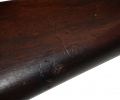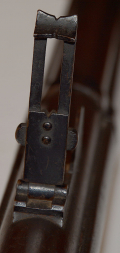site search
online catalog
US MODEL 1840 POMEROY CONTRACT MUSKET RIFLED AND SIGHTED

$2,450.00
Quantity Available: 1
Item Code: 490-4171
Shipping: Determined by Method & Location of buyer
To Order:
Call 717-334-0347,
Fax 717-334-5016, or E-mail
The US Model 1840 musket is complicated in nomenclature and production details. Initially designated the Model 1835, it was finally designated the 1840 and collectors occasionally call it the Model 1835/40. Production details are complicated by it being the last of the US flintlock muskets and most of them being altered to percussion to bring them up to par with the Model 1842 and many subsequently also rifled and sighted, as this one was, to catch up with the 1855 series of arms.
As initially configured, this was one of 7,000 produced on a U.S. contract 1840-1846 by Lemuel Pomeroy of Pittsfield, Mass., with Springfield turning out 30,421 1840-1844, and Daniel Nippes another 5,100 1843-1848. With the adoption of the percussion system with the Model 1842, almost all the Model 1840s seem to have remained unissued at least until conversion to percussion using the cone-in-barrel method starting in the late 1840s, part of a vast project involving almost eight-times as many older Model 1816 muskets as well. Moller (2.14) thinks almost all of Pomeroy’s 7,000 were among the 8,000 Model 1840 muskets altered by Watervliet Arsenal after October 1850 in Fiscal Year 1851. As part of this process the barrels and stocks were marked with an alpha-numeric mating code to keep them together during reassembly, something necessary for the hand-fitted Model 1816s, but not necessary, at least in theory, with the interchangeable Model 1840s. Ours shows a “Q 3” stamped on the comb forward of the buttplate tang. The matching code would have been stamped on the underside of the barrel. We have not pulled the barrel to check, since most of these no longer match.
When the army began rifling percussion altered flintlock muskets in 1856 at Harpers Ferry, Frankford and St. Louis, they seem to have appreciated the interchangeable parts of the Model 1840 and did not try to keep barrel and stock together. Thus, ours has a clearly dated 1841 lock and 1842 dated barrel that could reflect overlap in the initial assembly of the musket, but more likely results from the rifling and sighting. Some 20,980 cone-in-barrel percussion altered flintlock muskets were so altered for the Federal government from 1856 to 1859, with another 680 merely rifled, when the process was discontinued out of concern the barrels, at least of the older Model 1816s, could not take the increased pressure created in firing the expanding Minie ball.
This rates very good for condition. This wood to metal fit is tight. The barrel is full length, both sights are in place, including the altered front sight and complete rear sight. All bands, springs and swivels are there, along with correct cupped ramrod for the conical Minie ball. The metal is smooth, with the barrel showing an even brown finish, possibly indicating Navy issue- more on this below- and the mounts just slightly darker with the rear sight showing some faded blue. The markings are clear: U.S. / EB / (Circle) P on the left breech and 1842 on the breechplug tang, which are the US acceptance stamp, initials of Springfield Armory sub-inspector Elizur Bates, who inspected arms at Pomeroy’s works in March, April and May 1842, and the barrel production date. The lockplate is clearly stamped with a spread-winged eagle and L. POMEROY forward of the hammer and 1841 / U.S vertically on the rear of the plate.
The wood has nice color, good finish, very good edges, some scattered light handling marks with a two pairs of shallow drag lines on the wrist. The markings, however, are good. In addition to the mating code on the comb there are two partially rubbed but very legible cartouches on the counterpane: the oval with EB inspection mark of Bates forward the WAT final acceptance stamp of William A. Thornton at the lower. Mechanics function well; bore is clean with visible rifling.
These .69 rifled muskets saw a good deal of service early in the war, but were being phased out in the eastern theater as .58 caliber rifle musket production kicked in, but at Gettysburg Union units like the 15th Mass, 1st Minn, 69th P 9th Mass, 139th PA still had some of them, as did some units in Heth’s Confederate division. By late 1863 seem to have been largely in the hands of western and some rear-echelon units, but they were considered for wider issue again after the July 1864 call for 500,000 more troops, for in Fall 1864 the government ordered 5,000 cartridge boxes for the elongated ball .69 caliber cartridge in the new 1864 cartridge box pattern.
We also note that the Navy US acquired 1,800 rifled and sighted .69 muskets by purchase and exchange from the Army by November 1856. (Moller says 1,500; McAulay, 1,800.) McAulay mentions both Model 1840 and Model 1816/22 muskets in his discussion, and uses a Pomeroy Model 1840 in his illustration, though some argue these were coming from Harpers Ferry and likely all Model 1816/22/28 patterns. These muskets were specified as being browned and we note the brown barrel and apparently blackened bands on this one. We also note that in December 1859 Virginia was permitted to request rifled .69 caliber muskets as part of it arms militia arms allotment. Several hundred seem to have been then altered at Harpers Ferry for transfer to the state, it was likely they were Model 1840s, which we regarded as able to withstand the higher barrel pressures, but the exact number is unclear, as is whether they were sighted as well, though that seems likely.
This would make an especially nice addition to a collection or display of arms showing how the government tried to keep up with rapidly evolving and improving arms technology in the 1840s and 1850s. [sr] [ph:L]
DISCLAIMER: All firearms are sold as collector's items only - we do not accept responsibility as to the shooting safety or reliability of any antique firearm. All firearms are described as accurately as possible, given the restraints of a catalog listing length. We want satisfied customers & often "under" describe the weapons. Any city or state regulations regarding owning antique firearms are the responsibility of the purchaser. All firearms are "mechanically perfect" unless noted, but again, are NOT warranted as safe to fire.
~~~~~~~~~~~~~~~~~~~~~~~~~~~~~~~~~~~
THIS ITEM, AS WITH ALL OTHER ITEMS AVAILABLE ON OUR WEB SITE,
MAY BE PURCHASED THROUGH OUR LAYAWAY PROGRAM.
CLICK HERE FOR OUR POLICIES AND TERMS.
THANK YOU
Inquire About US MODEL 1840 POMEROY CONTRACT MUSKET RIFLED AND SIGHTED
For inquiries, please email us at [email protected]
Most Popular
Historical Firearms Stolen From The National Civil War Museum In Harrisburg, Pa »
Theft From Gravesite Of Gen. John Reynolds »
Cavalry Carbine Sling Swivel »
Fine Condition Brass Infantry Bugle Insignia »
featured item
RARE IDENTIFIED 65th NY SERGEANT’S JACKET, WITH MANSCRIPT MATERIAL: 1st U.S. CHASSEURS
This is an extremely rare, early-war uniform jacket, with related material, belonging to a sergeant of the 65th New York, who enlisted at the beginning of the war as the regiment’s commissary sergeant, and gained a lieutenant’s commission in a… (1179-233). Learn More »























